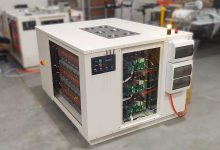An energy storage system made up of nine used Nissan Leaf electric vehicle batteries is to be installed on the grid in New Zealand.
The project, a joint venture between Melbourne-based battery technology company Relectrify and consumer-owned NZ electricity distributor Counties Power, will test the second-life battery system’s ability to provide redundancy, flexibility and resiliency for customers in a remote rural area.
The battery system combines Relectrify’s battery management system (BMS) and inverter technology – launched earlier this year – combined with roughly two tonnes of used EV batteries that will have the ability to store more than 120kWh of energy.
Relectrify’s business model is to tap the potentially huge supply of EV batteries as they are retired by manufacturers, which happens once they fall below 80 per cent of their original state of health, and give them a second life – ticking the boxes of lower cost and resource efficiency along the way. Relectrify’s technology also avoids the need for manual battery sorting, allowing for it to repurpose retired electric vehicle batteries at scale.
According to Relectrify co-founder and CEO Valentin Muenzel, second-life battery systems still have a great deal to give, with the installations the company has installed so far tracking at an average of 3,000-plus cycles.
“So, you know, if you compare that with new battery systems …it’s a bit shorter. But you have a much lower capex cost up front and 3,000 cycles is nothing to be shrugged at – that’s a very long period of time,” he told RenewEconomy.
“And particularly in, for example, the case of long line feeders where you may not be daily cycling… Why would you even use new batteries if you’re never going to get to three thousand cycles anyway?”
The Counties Power system, which is the largest Relectrify has deployed to date, has started its journey in the distribution company’s utility testing lab, where it is providing 380-415V 3-phase peak-shaving, before it is moved to its place at the end of a long power line.

“We’re using this in the test environment to really fully understand the benefits and the potential that we believe exists and then to be able to take that out to our networks,” said Moonis Vegdani, the head of emerging technology and product development at Counties Power.
“It’s about firstly understanding the benefits and then applying it to the real world, in essence, to our grid where we can actually come up with with quite a potentially exciting consumer value proposition,” added Vivek Rajendran, Counties Power general manager of strategy and business development.
“Relectrify’s technology unlocks a unique combination of strong performance and low price point with low environmental impact which aligns perfectly with Counties Power’s focus on enabling a smarter, sustainable and future-ready power network.”
Muenzel says that the New Zealand project is proving to be a valuable collaborative project for all parties involved, which in this case has included an international power utility and various automotive collaborators, seeking to validate the technology for use in key overseas markets.
“We take a very collaborative approach … to jointly figure out what value we can bring to the table,” he told RE.
“The car companies have the batteries and need to do something with the batteries, otherwise they have a lot of recycling on their hands right now and recycling something that still has a lot of value.
“The power companies have opportunities for storage, which they are looking to service, and ideally to service in situations where traditional network solutions are more expensive.
“And Relectrify fits in as the technology enabler. We build technology that makes it very easy to plug and play these second-life batteries, as opposed to other much more manual and much more cumbersome approaches that are less scalable,” he said.
“So we focus on having electronics where you just take the batteries out of the vehicle, plug our electronics on, connect them together into a big stack, and you’re ready to go and connect to the power grid. That’s that’s how we all fit into it.”
Relectrify, which was co-founded by Muenzel and Daniel Crowley in 2015, received financial backing from both the Clean Energy Finance Corporation and the Australian Renewable Energy Agency in 2017.
At the time, then ARENA CEO Ivor Frischknecht described the company as “led by bright and passionate Melbourne-based founders who are looking to bring an innovative idea to renewable energy storage solutions that can significantly lower the cost of energy storage in a sustainable way.”










